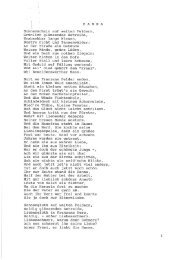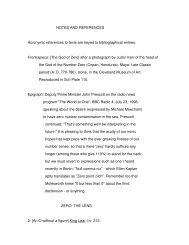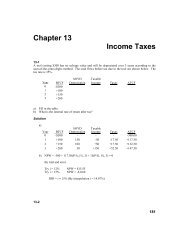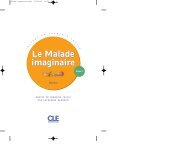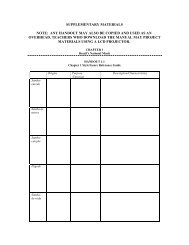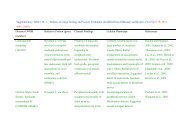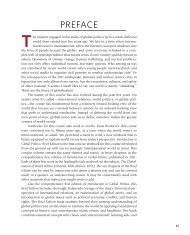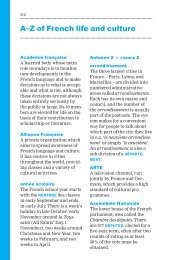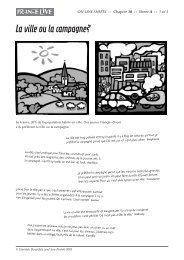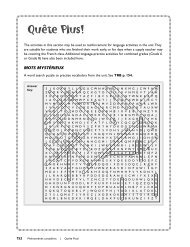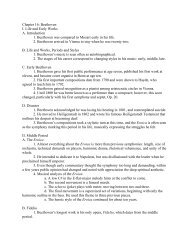CHAPTER 3 Consumer Preferences and Choice
CHAPTER 3 Consumer Preferences and Choice
CHAPTER 3 Consumer Preferences and Choice
Create successful ePaper yourself
Turn your PDF publications into a flip-book with our unique Google optimized e-Paper software.
03-Salvatore-Chap03.qxd 08-08-2008 12:41 PM Page 71<br />
Budget constraint<br />
The limitation on the<br />
amount of goods that a<br />
consumer can purchase<br />
imposed by his or her<br />
limited income <strong>and</strong> the<br />
prices of the goods.<br />
Budget line A line<br />
showing the various<br />
combinations of two<br />
goods that a consumer<br />
can purchase by<br />
spending all income.<br />
Definition of the Budget Line<br />
<strong>CHAPTER</strong> 3 <strong>Consumer</strong> <strong>Preferences</strong> <strong>and</strong> <strong>Choice</strong> 71<br />
In Section 3.2, we saw that we can represent a consumer’s tastes with an indifference<br />
map. We now introduce the constraints or limitations that a consumer faces in attempting<br />
to satisfy his or her wants. The amount of goods that a consumer can purchase over a<br />
given period of time is limited by the consumer’s income <strong>and</strong> by the prices of the goods<br />
that he or she must pay. In what follows we assume (realistically) that the consumer cannot<br />
affect the price of the goods he or she purchases. In economics jargon, we say that the<br />
consumer faces a budget constraint due to his or her limited income <strong>and</strong> the given prices<br />
of goods.<br />
By assuming that a consumer spends all of his or her income on good X (hamburgers)<br />
<strong>and</strong> on good Y (soft drinks), we can express the budget constraint as<br />
PXQX + PYQY = I [3.3]<br />
where PX is the price of good X, QX is the quantity of good X, PY is the price of good Y,<br />
QY is the quantity of good Y, <strong>and</strong> I is the consumer’s money income. Equation [3.3] postulates<br />
that the price of X times the quantity of X plus the price of Y times the quantity of<br />
Y equals the consumer’s money income. That is, the amount of money spent on X plus<br />
the amount spent on Y equals the consumer’s income. 10<br />
Suppose that PX = $2, PY = $1, <strong>and</strong> I = $10 per unit of time. This could, for example,<br />
be the situation of a student who has $10 per day to spend on snacks of hamburgers<br />
(good X) priced at $2 each <strong>and</strong> on soft drinks (good Y) priced at $1 each. By spending all<br />
income on Y, the consumer could purchase 10Y <strong>and</strong> 0X. This defines endpoint J on the<br />
vertical axis of Figure 3.6. Alternatively, by spending all income on X, the consumer<br />
could purchase 5X <strong>and</strong> 0Y. This defines endpoint K on the horizontal axis. By joining endpoints<br />
J <strong>and</strong> K with a straight line we get the consumer’s budget line. This line shows the<br />
various combinations of X <strong>and</strong> Y that the consumer can purchase by spending all income<br />
at the given prices of the two goods. For example, starting at endpoint J, the consumer<br />
could give up two units of Y <strong>and</strong> use the $2 not spent on Y to purchase the first unit of X<br />
<strong>and</strong> reach point L. By giving up another 2Y, he or she could purchase the second unit of<br />
X. The slope of −2 of budget line JK shows that for each 2Y the consumer gives up, he or<br />
she can purchase 1X more.<br />
By rearranging equation [3.3], we can express the consumer’s budget constraint in a<br />
different <strong>and</strong> more useful form, as follows. By subtracting the term PXQX from both sides<br />
of equation [3.3] we get<br />
PYQY = I − PXQX<br />
10 Equation [3.3] could be generalized to deal with any number of goods. However, as pointed out, we deal<br />
with only two goods for purposes of diagrammatic analysis.<br />
[3.3A]<br />
By then dividing both sides of equation [3.3A] by PY, we isolate QY on the left-h<strong>and</strong> side<br />
<strong>and</strong> define equation [3.4]:<br />
QY = I/PY − (PX /PY)QX<br />
[3.4]



